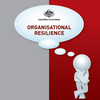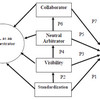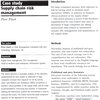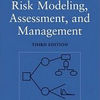 What happens when a business is disabled for a length of time? What are the impacts on its profitability, service delivery, and employees? What are the flow-on effects to the broader community? What are the key attributes that can help a business to bounce back or bounce forward from a disruption? Those are the issues the Australian Resilience Expert Advisory Group REAG discusses in a position paper titled Organisational Resilience. I was alerted to this paper by a recent post on the blog of Ken Simpson, a resilience expert and blogger from Australia. The paper details a set of core principles and resilience attributes that can be applied across a diverse range of critical infrastructure organisations, and although it is aimed at the individual business and its management, it is a paper that makes sense in a range of organizational settings.
What happens when a business is disabled for a length of time? What are the impacts on its profitability, service delivery, and employees? What are the flow-on effects to the broader community? What are the key attributes that can help a business to bounce back or bounce forward from a disruption? Those are the issues the Australian Resilience Expert Advisory Group REAG discusses in a position paper titled Organisational Resilience. I was alerted to this paper by a recent post on the blog of Ken Simpson, a resilience expert and blogger from Australia. The paper details a set of core principles and resilience attributes that can be applied across a diverse range of critical infrastructure organisations, and although it is aimed at the individual business and its management, it is a paper that makes sense in a range of organizational settings.
Resilience redefined
The need to manage uncertainty in modern societies and economies that are complex and vastly interconnected, and that have created what many call a “risk society”, has lead to an increasing popularity of the concept of “resilience” and what resilience entails. In recent years, Yossi Sheffi and his Resilient Enterprise have emerged as one of the proponents of resilience, but he is undoubtedly not the only one, as Martin Christopher and the University of Cranfield were among the first to investigate resilience in supply chains. Now Australia has joined the ranks.
Four approaches
While applying the concept of resilience to the fundamental elements of infrastructure on which our society and economy depends is obviously imperative, the nature of the challenges critical infrastructure organisations encounter means that applying the concept of resilience is not simple and straightforward. Resilience, so the paper, is not just sound risk management, effective emergency response and crisis management, or business continuity management. Resilience expresses itself in one of four ways of how an organization approaches adversity:
- Decline
- An organisation accepts that adversity may cause it to cease operating
- Survive
- An organisation’s resilience objective is to exist in a reduced form after adversity
- Bounce Back
- An organisation’s resilience objective is to regain pre-adversity position quickly and effectively
- Bounce Forward
- An organisation’s resilience objective is to improve aspects of the organisation’s functioning so that in adversity it not only survives but possibly gains from the situation
I find this a highly interesting perspective, and particularly the latter reflects much of what I wrote in an earlier post on Organizing Resilience, where
Resilience is the capacity to rebound from adversity strengthened and more resourceful.
It is also interesting to compare these approaches with the New Zealand Resilient Organisations project, where
Resilience is a 3-fold construct, working in a complex, dynamic and interconnected fashion depending on 1) keystone vulnerabilities, criticality and preparedness, 2) situation awareness, stemming from an assessment of the keystone vulnerabilities, and 3) adaptive capacity.
I should also not forget Asbjørnslett and his 1997 report on how to assess the vulnerability of production systems, where
A robust or resilient system is able to withstand or absorb disturbances without catastrophic failure and still persist. Robust means being able to resist an accidental event and return to the same stable situation than before the event. Resilient means being able to return to a new (often “lower”) stable situation than before the event.
There is a distinct notion of severity in these definitions. In a business setting, the ability to survive (resilience) is much more important than the ability to quickly regain stability (robustness), something that lead me towards my own definitions of resilience, robustness, flexibility and agility.
What then does Australia view as the essential ingredients of resilience?
Resilience is frequently defined as an ability to bounce back from adversity. While this is a useful definition in many cases, and is an often-desired outcome in a critical infrastructure context, it does have limitations. This is because organisations can use times of adversity to achieve positive change – so they should be open to both the possibility for bouncing back, but also taking opportunities to bounce forward.
That is a definition that I like, and very much like resilience as adaptive transformation.
Three attributes
The REAG has also identified the behavioral attributes of resilience that fall into three categories, as they relate to:
- Leadership and Culture
- Networks
- Change Ready
Leadership and culture refers to an organization that, among other things,
- develops an organizational mindset/culture of enthusiasm for challenge, agility, flexibility, adaptive capacity, innovation and taking opportunity
- fosters an environment that supports agility, flexibility and initiative in decision making through trust, clear purpose and empowerment of employees
A lot of nice keywords here (agility, flexibility, adaptive capacity…), but not really much substance.
The next attribute, Networks, is slight better described, and “adds some meat to the bone”, as we say in Norway. This attribute refers to organizations that, among other things,
- establishes relationships, mutual aid arrangements and regulatory partnerships
- understands its community interconnectedness and its vulnerabilities across all aspects of supply chains and distribution networks
I’m not sure how “Networks” is a behavioral attribute, since the word “Networks”isn’t even an adjevtive, but anyway…
Finally, the last attribute, Change Ready, is the attribute that fully embodies what organizational resilience really means. A change-ready organization
- promotes proactive anticipation and preparation for future challenges
- develops a forewarning of disruption threats and their effects through sourcing a diversity of views, increasing sensitivity and alertness, and understanding social vulnerability
- promotes empowered and broadly embraced organisational and individual self-efficacy, as well as enthusiasm for finding effective solutions to complex challenges
- promotes requisite decision making using both rational and intuitive abilities, and
- promotes critical reflective learning, lesson retention, knowledge sharing and continuous improvement.
These attributes, so the paper says, can be applied to any aspect of organizational capability development, similar to the above mentioned post on Organizing Resilience.
Case studies
The second half of the paper is devoted to seven case studies and the resilience lessons these companies made:
- Case 1: the lawyers and the accountants
- Case 2: the hi-tech laboratory instrumentation company
- Case 3: the wholesaler/retailer of household products
- Case 4: the freight company
- Case 5: the communications company
- Case 6: the power station project
- Case 7: the electronic design and manufacturing company
All in all, highly interesting cases that truly showcase resilience and non-resilience.
Conclusion
There isn’t much more to say about this paper. In my opinion the Australians have hit the nail on the head here. What do you think?
Reference
REAG (2011) Organisational Resilience: A position paper for critical infrastructure. Australian Case studies. The Australian Government Resilience Expert Advisory Group.
Download
- tisn.gov.au: Organisational Resilience
Related links
- tisn.gov.au: Critical Infrastructure Resilience
- blog.vrg.net.au: Australian government position on resilience
Related posts
- husdal.com: Organizing Resilience
- husdal.com: Resilient Organisations
- husdal.com: Resilience – adaptation or transformation?












